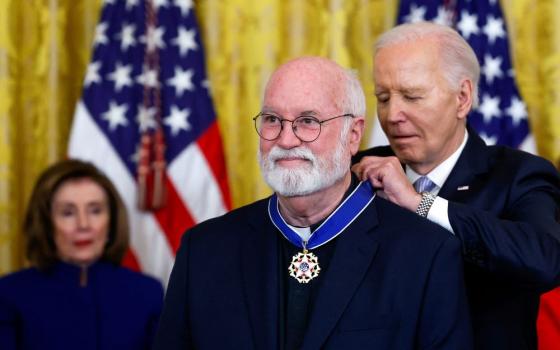Doesn’t it seem strange that the man who was transformed in today’s Gospel passage said nary a word until after he was healed? He didn’t ask Jesus for a cure nor did he tell his tale of being relegated to begging. In the beginning, he was just there, the object of other people’s judgment. He was just there for Jesus to see.
Jesus saw in him the potential of carrying God’s works forward. Thus, continuing the work of the Creator, he molded clay and touched the man. Using the mud as if it were the oil of anointing, he smeared it on the man’s useless eyes.
This scriptural account bursts with images of creation, reminding the reader that everything begins with God’s loving initiative. God always takes the first step.
| Fourth Sunday of Lent |
| 1 Samuel 16:1b, 6-7; 10-13a Psalm 23 Ephesians 5:8-14 John 9:1-41 |
The second step, acceptance, depends on humanity. The man who could not see was receptive to Jesus’ word. He accepted Jesus’ command, although he could have had no clue as to the outcome of his obedience. He came back transformed.
That was when his troubles began. It’s not easy for people to learn to see someone in a new way. The neighbors had adjusted quite well to the man’s physical incapacity. When they encountered him with his faculties intact, they doubted their own eyes and wondered about justice, about sin and just punishment. In the light of their confusion, the man did the unthinkable: He identified himself not only as the one they had known but also as someone recreated in the image of the man who had brought about his transformation. He said, “I am.”
They asked the question that solidified the controversy: “How were your eyes opened?”
The short answer was “The man called Jesus.” They couldn’t understand that; they took him to the Pharisees.
The man called Jesus, the source of transformation, became the center of confusion and discord. The religious leaders, self-assured arbiters of true faith, found a quick and easy answer: “This work can’t be from God because it was done on the Sabbath. Everyone knows that neither God nor man is allowed to work on that day.”
Even some of the religious leaders choked on that answer. If the man called Jesus had brought about a great good, how could he be a sinner?
So the authorities again questioned the man. Insisting that he tell the truth, they prefaced their question with their own certainty: “We know that he is a sinner.”
The man-who-saw refused to go along with that description. He simply repeated what had happened to him: “I was blind, and now I see.” He then took the liberty of offering his own theological commentary: “Never, ever, has anyone healed someone born blind! How could he do it without God’s help?”

His challenge to their rigid, dogmatic logic proved intolerable. To back up their unassailable orthodoxy, they reminded the healed man that his condition was obvious — he was born blind, he was immersed in sin. How dare he instruct them? They did the only thing that made sense to them: They excommunicated him.
Having heard that the man was suffering for his sake, Jesus came to offer him solidarity and insight. As in their first encounter, Jesus took the initiative. He now asked if the seeing man believed in “the Son of Man,” the one who was to come.
In a scene that parallels the encounter between Jesus and the Samaritan woman, the man asks who that might be and Jesus identifies himself. Jesus’ self-identification ratified what the man had told the leaders: Jesus had come from God. He could now wholeheartedly say, “I do believe,” a statement that could be translated as a profound and joyful shout, “I see!”
He was never named. The word used to describe him was anthropos, the Greek word designating a human being without specifying gender, ethnicity or historical context. The one born blind is everyone.
When we hear this Gospel, we are challenged to figure out which part we are playing in the drama and which we wish to play. We may be people definitively bound by our unshakeable convictions. We may be people who wonder what God might be up to. We may choose to allow authorities to give us the answers.
Regardless, we are invited to be anthropos, people who realize we are somehow blind and are willing to be given sight.
[Mary M. McGlone, a Sister of St. Joseph of Carondelet, is currently writing the history of the Sisters of St. Joseph in the U.S.]








